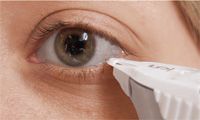New tear film technologies join the fight against dry eye
Clinically friendly technology for the evaluation of the tear film will play an increasing role in helping optometrists diagnose and treat dry eye disease.

"In the realm of tear film evaluation, there has been very little that has come our way that has been clinically friendly," said Dr. Bitton, associate professor and externship director, University of Montreal School of Optometry, Montreal, Canada.
"There have been numerous technological advances available for research, but they often require substantial technical expertise, dedicated space, and are costly, rendering them impractical for use in most clinical practices," she noted.
Traditional methods

According to Dr. Bitton, most optometrists are very comfortable with these traditional tests, although most are subjective in nature and provide limited information on their own. Of all the tear film technologies becoming available, she believes it's most likely that clinicians will embrace the os-mometer, which is compact and clinically friendly.
The most recent osmometer (TearLab Os-molarity System, TearLab Corp.) uses a microchip to measure the concentration, or osmolarity, of a small tear sample, Dr. Bit-ton said. A comparative chart allows the clinician to assess the severity of the dry-ness from the osmolarity value obtained.
"This is a completely objective test that can not only help the clinician assess dry-ness at the onset, but can also follow the progress of the treatment of the dry eye patient," she said. "It eliminates subjectivity. The device provides a number so optometrists and patients can follow the progress of that number, just like a cholesterol or blood pressure number.
"The test is quick, reliable, and doesn't take a lot of chair time," Dr. Bitton added. "Most of the other technologies require technical support and expertise, take longer to obtain a result from a tear sample, and require much larger samples, which can be difficult to obtain in patients with dry eye."
Newsletter
Want more insights like this? Subscribe to Optometry Times and get clinical pearls and practice tips delivered straight to your inbox.